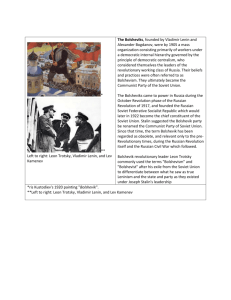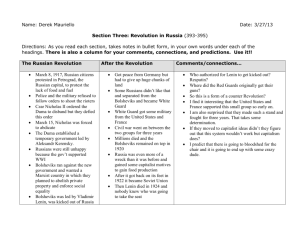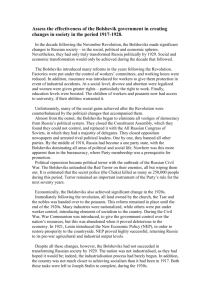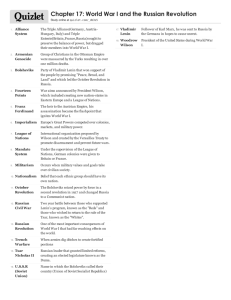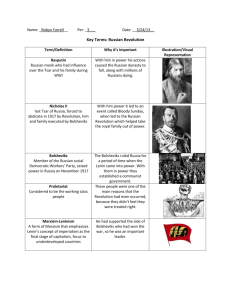History’s Greatest Heist: The Looting of Russia by the Bolsheviks.... McMeekin. Yale University Press: New Haven and London, 2009. xxii,...
advertisement
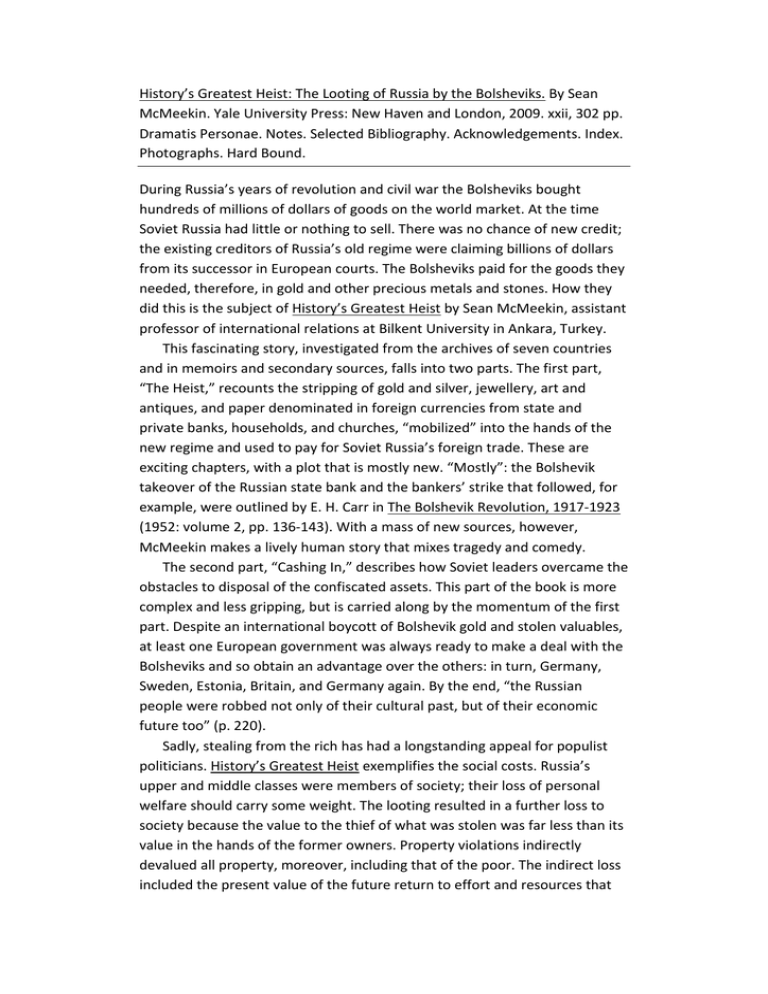
History’s Greatest Heist: The Looting of Russia by the Bolsheviks. By Sean McMeekin. Yale University Press: New Haven and London, 2009. xxii, 302 pp. Dramatis Personae. Notes. Selected Bibliography. Acknowledgements. Index. Photographs. Hard Bound. During Russia’s years of revolution and civil war the Bolsheviks bought hundreds of millions of dollars of goods on the world market. At the time Soviet Russia had little or nothing to sell. There was no chance of new credit; the existing creditors of Russia’s old regime were claiming billions of dollars from its successor in European courts. The Bolsheviks paid for the goods they needed, therefore, in gold and other precious metals and stones. How they did this is the subject of History’s Greatest Heist by Sean McMeekin, assistant professor of international relations at Bilkent University in Ankara, Turkey. This fascinating story, investigated from the archives of seven countries and in memoirs and secondary sources, falls into two parts. The first part, “The Heist,” recounts the stripping of gold and silver, jewellery, art and antiques, and paper denominated in foreign currencies from state and private banks, households, and churches, “mobilized” into the hands of the new regime and used to pay for Soviet Russia’s foreign trade. These are exciting chapters, with a plot that is mostly new. “Mostly”: the Bolshevik takeover of the Russian state bank and the bankers’ strike that followed, for example, were outlined by E. H. Carr in The Bolshevik Revolution, 1917-1923 (1952: volume 2, pp. 136-143). With a mass of new sources, however, McMeekin makes a lively human story that mixes tragedy and comedy. The second part, “Cashing In,” describes how Soviet leaders overcame the obstacles to disposal of the confiscated assets. This part of the book is more complex and less gripping, but is carried along by the momentum of the first part. Despite an international boycott of Bolshevik gold and stolen valuables, at least one European government was always ready to make a deal with the Bolsheviks and so obtain an advantage over the others: in turn, Germany, Sweden, Estonia, Britain, and Germany again. By the end, “the Russian people were robbed not only of their cultural past, but of their economic future too” (p. 220). Sadly, stealing from the rich has had a longstanding appeal for populist politicians. History’s Greatest Heist exemplifies the social costs. Russia’s upper and middle classes were members of society; their loss of personal welfare should carry some weight. The looting resulted in a further loss to society because the value to the thief of what was stolen was far less than its value in the hands of the former owners. Property violations indirectly devalued all property, moreover, including that of the poor. The indirect loss included the present value of the future return to effort and resources that 2 would not now be invested for fear of further confiscation. Beyond that, accumulation would have to be coerced, not voluntary. The story is not always easy to follow. McMeekin describes the U.S. government’s attempts to monitor the Russian export of gold and valuables through Reval: “it was like putting together a puzzle with pieces that never quite fit” (p. 162). I felt the same, trying to absorb an unstoppable flow of hundreds, thousands, and millions of incomparable units: tsarist and Soviet rubles, dollars of the past and present, and kilograms and tons of gold. I longed for a stock-taking, preferably in some common currency. A rough account of gold in and out between specific dates, like that newly published by Elena Osokina in Zoloto dlia industrializatsii: Torgsin (2009: p. 524), would have helped tremendously. But the book has not a single table. According to McMeekin, between 1920 and 1922 the Bolsheviks exported gold worth over $350 million (p. 195). (Osokina’s figures agree.) Russian national income in 1913 had reached $10 billion (20 billion rubles); imports were $700 million. Thus, $350 million enabled Soviet Russia to buy goods worth around 6 months of imports at the prewar rate, although national income had fallen by at least one half, and merchandise exports were now negligible. This seems a better context for McMeekin’s figures than farfetched conversions into present-day dollars (pp. xii-xv). History’s greatest heist? A big one, certainly, although Hitler took much more from France in World War II. To conclude, McMeekin’s story is one from which scholars, students, and lay readers will gain enlightenment, enjoyment, sadness, and frustration in roughly equal measures. Mark Harrison University of Warwick


